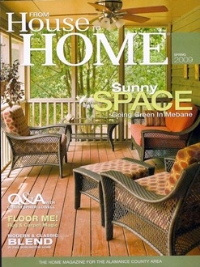Trip also had an assortment of stone tiles (with which he had redone his own shower in a wonderful patchwork of complementary granites). This treasure trove provided stone for a limestone/granite floor and accents for the guest bath, as well as the kitchen backsplash. The remnants rack at a local granite store provided a beautiful counter for the master bath vanity area. Finally, some old decorative tiles from Greensboro Architectural Salvage will hold soap and towels in the guest bath.
Where possible, new materials purchased were selected for recycled content. The kitchen countertops are Richlite, a solid surface made with recycled paper and created by Dave Banko of Counterpart LLC in Raleigh, and new tiles throughout the house have recycled content. These recycled content tiles are from Common Ground Green Building Supply in Durham, which also supplied paint and floor finishing. Common Ground sources many other green building materials, like flooring, countertops and cabinetry.
Finishes are a major source of toxic emissions in homes. Paint, varnishes, polyurethane, vinyl flooring - these are the things that create that “new house smell.” Unfortunately, that new house smell isn’t good for you, especially when sealed into an energy-efficient house. So this project used non-toxic materials. For starters, we used Mythic® paint, which is a non-toxic, ultra-low odor paint. For another application, Melissa had heard of a natural ebonizing method for wood. Put steel wool in white vinegar for a week and it will create a lovely translucent black finish on wood. Using some of that previous-lot white oak, the builders made two beautiful ebony-looking vanities. And finally, rather than finishing the floor with polyurethane, even a water-based polyurethane, we used a new non-toxic finish which will look like an old floor. AFM Naturals Oil Wax Finishapplies more easily, like an oil, and uses pine resins to create a durable finish. A major advantage of this finish is that, when the inevitable accident happens in one spot, you don’t need to refinish the whole floor, just retouch that one spot.
Bringing the function of the house into the 21st century meant energy and water efficiency. Appliances are all Energy Star, as are fans and most light fixtures. Period-looking lights are from Schoolhouse Electric, crafted affordably here in the USA. Light cans are equipped with LED bulbs that screw in a regular socket. (LEDs or Light-emitting Diodes, and depending on the use are approx. 80% more efficient than incandescent and about 50% more efficient than fluorescent). These were made by Cree, a Durham company, and picked up at Costco for $30. They should save about $150 over the life of the bulb). Non-LED bulbs will be fluorescent. More efficient bulbs not only save electricity, they emit less heat so your air conditioner doesn’t have to work as hard, saving even more energy.
Toilets meet the relatively new EPA Water Sense standards, the water equivalent of Energy Star. What you may not know is how much water and energy use are related. It takes 3 times the water to provide electricity to a house than that house uses for household washing and flushing. Conversely, it takes a great deal of electricity to pump and treat water. As such, saving water saves energy and vice versa. So we wanted to minimize use of both for multiplier benefits. (Add that to the fact that most coal plants are only 30% efficient (only 30% of the coal burned becomes electricity), so saving 30 units of electricity actually saves 100 units of coal!)
Materials, finishes, appliances, energy and water efficiency -- that catches us up to the present, Green reader. Tune in next time for the finishing touches and commissioning of the house.

















